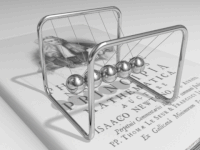
Photo from wikipedia
Undesired oscillations are often encountered in controlled systems at steady state due to high-frequency (HF) periodic disturbance and/or feedback noises. This article presents a computationally efficient alternative to derive an… Click to show full abstract
Undesired oscillations are often encountered in controlled systems at steady state due to high-frequency (HF) periodic disturbance and/or feedback noises. This article presents a computationally efficient alternative to derive an analytical harmonic model (AHM) that expresses the oscillatory variable as a series of harmonic kernel vectors and a position-independent harmonic amplitude vector for identifying the dominant harmonic components of the undesired effects on the manipulated variables. Illustrated in the context of an aircraft pressure-controlled piston pump (PC-PP) where the pressure feedback pulsations and the torque disturbances from the piston/slipper assemblies lead to HF swash-plate (SP) oscillation at steady state, the AHM and its significance were investigated experimentally on a PC-PP test-rig capable of simultaneously measuring the HF feedback pressure and SP-angle. Good agreements between the experimental and numerical results validate the AHM, and reveal that the HF SP-oscillation is dominated by its fundamental harmonic component, and primarily contributed by the disturbance torque.
Journal Title: IEEE/ASME Transactions on Mechatronics
Year Published: 2021
Link to full text (if available)
Share on Social Media: Sign Up to like & get
recommendations!